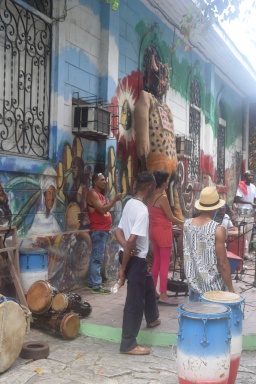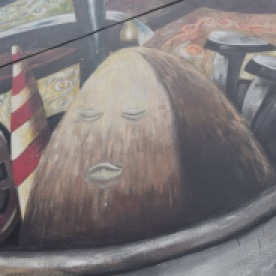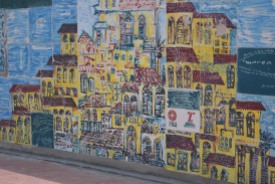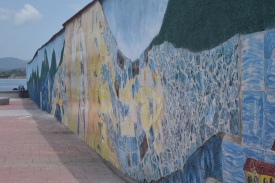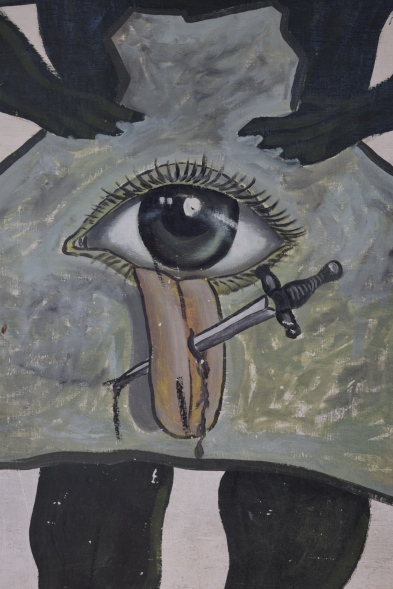Image: Dr. Raúl Miyares, taking his ease in the “Living Room” by Jose M. Diaz Mayim on the malecón of Santiago de Cuba, Cuba.
Hit the highway anywhere in the country, and the transportation challenge is evident. If you have a motorized vehicle and have room, by law you must stop to pick up passengers who flag you down.
Rental and hired vehicles are excepted. Due to the embargo and developing oil crisis in Venezuela, there is little fuel available. Of course, most of us are aware of the large US vehicles still on the road held together by inventar, the concept of making due which is evident everywhere you look. So, carts drawn by horse, mule and oxen are not unusual along the highways and byways of anywhere in the country outside major cities.
Now, keep in mind that Havana is located in the Northwest part of Cuba, and is only 180 km from Key West, Florida. Culturally, embargo or not, it has always looked to the north.
Santiago de Cuba is on the Southeastern end of the island, some 870 km from Havana (a 14-hour bus ride or a short flight that only extranjeros for the most part can afford), and a world away from the capital. It really feels like we are in a different country. There is no big-city attitude. Along with the climate, the people are warmer here, friendlier and the music is much louder. With only 246 km to Kingston, Jamaica or 390km to Haiti, it is not surprisingly therefore that Santiago looks to the Caribbean for its cultural connections.
Raúl Miyares, a researcher with La Casa del Caribe, has provided our anthropology class with lectures on Cuban slavery, coffee and sugar plantations, and Afro-Cuban religions. As this organization is closely connected with the cultural presence in Stgo, he is a veritable gold mine of information regarding art, artists, and has interesting connections within the community. Check our their Facebook page to get a flavour of what I am talking about.
Images: Celebrating Festival del Caribe at La Casa del Caribe, July 2016
When I explained my project, he not only provided me with a copy of his book and his thesis, he also agreed to take me on a tour of some important pieces of sanctioned public art in Stgo. Let me share with you some of what we saw.
 Inaugurated in 1991 are two important pieces located to the entrance of the city of Santiago de Cuba. At 16 meters (the tallest statue in the country), the statue of Antonio Maceo Grajales – by Alberto Lescay, and the 23 machetes – by Guarionex Ferrer, represent the renewed fight for independence from Spain which started March 23, 1878.
Inaugurated in 1991 are two important pieces located to the entrance of the city of Santiago de Cuba. At 16 meters (the tallest statue in the country), the statue of Antonio Maceo Grajales – by Alberto Lescay, and the 23 machetes – by Guarionex Ferrer, represent the renewed fight for independence from Spain which started March 23, 1878.
 José Martí, the beloved Cuban hero and literary figure in another magnificent piece by Lescay, very reminiscent of el monumento del cimarrón.
José Martí, the beloved Cuban hero and literary figure in another magnificent piece by Lescay, very reminiscent of el monumento del cimarrón.
Several pieces of modern art located in Vista Alegre, an upscale neighbourhood of Santiago de Cuba where the two buildings of la Casa del Caribe are located. The top right-hand corner is another piece by Lescay.
The photos above and those that follow are of murals created by an international group called Inter-Nos. The images are vivid however the older ones are now starting to lose their vibrancy.
This one is called Rituales de resistencia and once again, the nganga is present, the receptacle which is the source of spirit and connection for many of the Afro-Cuban religions.
This one, another Inter-Nos piece, is called Conección a la vida and is from 2008. Raúl and our driver are in the bottom left-hand corner.
Another piece reflecting heroes of the revolution. This one is a fountain, which when running, makes it look like it is floating on the water. Santiago de Cuba is in drought conditions every July so I never saw it running.

This amazing mural, with a definite Japanese influence, is on the wall nursery school, tucked away on a back street.
This wall was located on the malecón, near the foot of our street, Santa Lucia. The large image is a representation of la virgen de la caridad del Cobre.
And finally, if you weren’t sure that Afro-Cuban religion has an important role to play, here are some final images to leave you with. Raúl took us to visit Madeleine, an espirtualista, who lives in El Cobre. These photos were taken in his home, however the mala vista, (the eye and tongue with the sword) through it can be found in many homes and businesses throughout Cuba. It is a charm for protection.
I am deeply indebted to Raúl Miyares for his support, assistance and continued friendship. He also has the most dramatic rr’s that I have ever heard. I shall always remember them with fondness.





